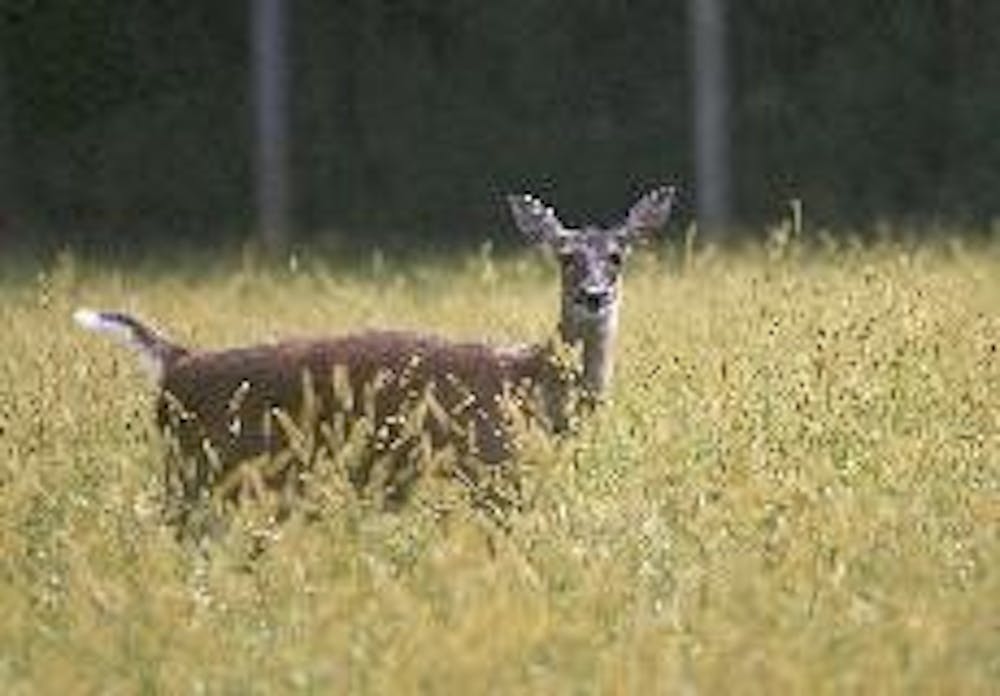
The Oxford Deer Project was created to help citizens understand the number of deer that exist in the city and to see if they pose a problem to residents.
Oxford residents may be seeing more than one additional Bambi, yet according to preliminary results from an ongoing survey, not many residents are too concerned about a rising deer population in Oxford.
A presentation was given by Miami University's Institute of Environmental Sciences (IES) Thursday evening in Boyd Hall regarding an ongoing online survey with the Oxford Deer Project. Oxford residents can still participate until April 25.
According to the Web site for the Oxford Deer Project, the white-tailed deer population throughout Ohio has risen from 17,000 in 1970 to approximately 600,000 as of 2006, with an all-time record of 700,000 reached in 2004.
Miami University professor of zoology Thomas Crist said Oxford's growing deer population is a result of increased development of land in conjunction with the deer's natural tendency to reside at the edge of forests. He said that due to this, the issue warranted examination by the Oxford Environmental Commission (EC) in 2006.
Oxford EC member Prue Dana, vice mayor of Oxford, described the duties of this commission as mainly a variety of cleanup projects.
"(The EP) handles everything from yard waste to picking up recycling to (controlling) storm water to handling the deer problem," Dana said.
The EC worked - along with a group of students and professors from IES - in fall 2006 to conduct a survey of public opinion.
In addition, four infrared cameras were set up at various points in Oxford to survey the deer population, according to Sharrah Moss, a Miami graduate student involved with the project.
She said that despite the installation of cameras, it was difficult to determine the correct deer population.
"A population estimate still could not be made from this, however we were able to find out information about (the deer population's) health and the male to female ratios," Moss said.
Enjoy what you're reading?
Signup for our newsletter
Moss said that the results of the survey so far did indicate a problem, though residents still seem to enjoy the wildlife that the deer bring to the area.
"The majority (of those surveyed) did say there is a problem, but they also say they enjoy watching the deer," Moss said. "They feel the problem is deer-vehicle collisions, a major concern, followed by damage to vegetation."
Mark Boardman, director of the IES, said that the results of the survey so far did not turn out how he expected.
"(I was) surprised that an awful lot of people thought this wasn't a problem," Boardman said. "Most people who did feel it was a problem liked seeing deer but felt their problems needed to be fixed."
Moss said less than half of those surveyed so far reported damage from the deer.
"Approximately 40 percent of people surveyed showed no damage at all," she said.
Dana, an Oxford resident, stressed the uneasy relationship carried on between humans and deer in the Oxford area and cited certain examples.
"The deer here are all over the suburbs," Dana said. "They eat everyone's plants, both ornamental and garden."
Dana also cites more serious happenings as a result of the deer population.
"Car accidents and fatalities involving deer have escalated," Dana said. "They also have been part of two accidents on campus at Miami. Either last year or the year before a deer jumped through a window at Shriver (Center). A deer also jumped through a window at Upham (Hall), and in both cases the deer had to be shot because of glass wounds."
Crist also explained other reasons contributing to the deer problem.
"New land practices also have contributed to the problem, as well as development," he said. "Farmers using riparian buffers (areas of woods planted by farmers between the crop land and sources of water, to catch the runoff pollution from contaminating the water) to make the land more attractive for deer. Also, remember that suburban areas are often built into wooden areas."
One possible solution to the increase in deer population; according to Crist, with whom the IES consulted early on in their process; includes hunting.
"(There could be) more hunting, which has some effect, but isn't too efficient unless you remove the does," Crist said.
Crist did, however, emphasize further complications regarding this possible solution.
"This (increased hunting) can't be used in suburban areas, where the problems mostly are," Crist said.
Monica Rakovan, interim deputy director of the IES, hypothesized her own reasons for the growing population.
"A reason for the escalating numbers might be a decease of hunters," Rakovan said.
Despite Boardman's reaction to the survey results, he believes that through education regarding safety tips about deer problems, Oxford can fix the problems of deer interactions with humans, such as motor vehicle accidents and vegetation damage, while also preserving the deer population.
Other recommendations involve promoting highway safety and driver awareness through deer crossing signs and clearing away the vegetation on roadways.




